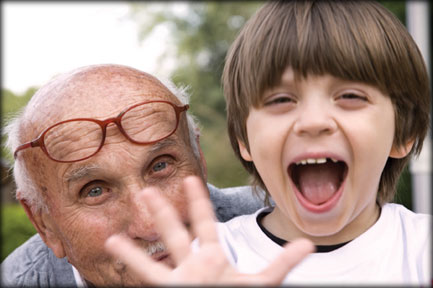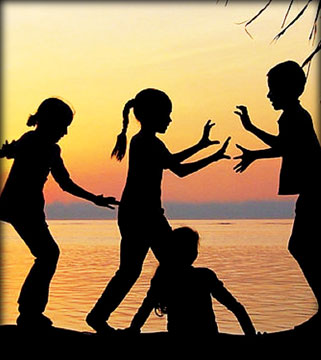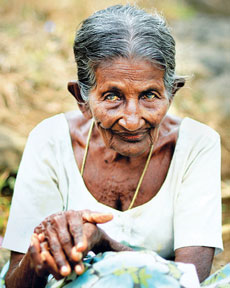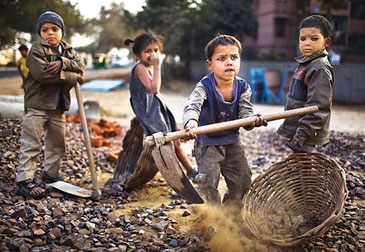|
Tuesday is Children’s and Elders’ Day :
What does the future hold for them?
by Carol Aloysius
Children and elders: Poles apart in age, but nevertheless the two
most vulnerable segments of society. Looking back on our own childhood,
most of us from privileged backgrounds would remember the joys of
growing up, the toys we were showered with, birthday celebrations that
our parents held for us, picnics, sea baths, train rides, story books
and the many wonderful things that make a joyous childhood.
|

A better world for children and the elderly |
Yet, for more than two-third of the world’s population living below
the poverty line, especially children living in the South Asian region,
childhood holds no such happy memories. Rather, they have unhappy,
bitter memories of waking up at the crack of dawn to begin their
numerous household chores, accompanying their parents for miles on the
cold streets to beg for food, without shoes to protect their tender feet
from stones and pieces of glass strewn on the roads, or a raincoat or
umbrella to shield them from the rain and sun.
Many of them survive on just one meal a day, a piece of bread with
gravy which a hotel owner may give them from leftovers, or share a plate
of rice and curry which a benevolent passerby may offer them as a dana.
Tough battle
Growing up in makeshift shacks or on the streets, they have learned
that life is one tough battle. Only the fittest survive. So, they end up
ganging with other children like themselves to steal, peddle narcotics,
and even sell their bodies to earn enough money to buy themselves a
decent meal.
Some of them, if lucky, manage to secure temporary jobs at nominal
wages, working in boutiques, washing dirty plates and sweeping floors,
selling newspapers or sweep tickets. Others push heavy carts they can
barely move, overflowing with fruit, vegetables, grain and coconuts.
Still others crush stones in quarries, or weave carpets that only tiny
fingers can handle. If they are lucky, their employers may give them a
cup of plain tea and a meal to get by. If not, they pay for their meal
or survive on a cigarette or a chew of betel.
Schooling is only a dream for many of them. At the most, they attend
school till the fifth grade and drop out when their parents need them to
stay at home to look after younger siblings or work in the fields or
earn an income to supplement their limited household earnings.

A happy and carefree childhood for all children should be
the aim |
Growing up in a hurry, they whiz through their childhood years
joylessly, passing through adolescence to youth to adulthood without
even being aware of the changes that take place in their bodies
physically and mentally as they leave their childhood behind, which
leaves them confused and frightened.
Vulnerable to abuse
With no one to turn to, peer education is their best option, which is
often misleading and makes them vulnerable to more abuse, often in the
form of sexual abuse. Homosexual predators prey on their obvious
vulnerability and lure them into the world of commercial sex. Studies
estimate that Sri Lanka has over 30,000 commercial sex workers, most of
them being between the ages of 12 and 25.
The Lankan child
Compared to children in other countries in Asia such as India,
Pakistan, Nepal and Bangladesh, the Sri Lankan child enjoys a better
quality of life due to free education and free health, and numerous
interventions initiated on their behalf by both government and
non-government parties in the past and the present. Still much needs to
be done for the future underprivileged citizens of our country.
For instance, recent reports have revealed that child abuse is on the
rise. Rape, incest, physical and mental abuse of children take place on
a daily basis. And, while the number of children engaged in domestic
labour is now at a new low, thanks to a new clause banning children
under the age of 14 from being engaged as domestics, ratified by the
International Labour Organisation, we still read reports of cases being
filed against employers who have burned, cut, badly bruised or thrown
chillie powder in children’s faces as ‘punishment’. Many are young
children they allegedly ‘adopted’ to get over this new law.
Sri Lanka is one of the earliest signatories of the Charter for Women
and Child Rights. However, there are still many gaps between what the
then authorities promised to uphold and the promises that have not been
honoured. These gaps need to be closed to give children their rights as
enshrined in the Convention on the Rights of the Child.
What are child rights?
Just what are these rights? And what is the Convention on the Rights
of the Child?
|

The greying population is increasing |
The United Nations Convention on the Rights of the Child (UNCRC) is a
human rights treaty setting out the civil, political, economic, social,
health and cultural rights of children. The Convention defines a child
as any human being under the age of 18, unless specified differently by
the domestic legislation of states. Nations that ratify this Convention
are bound to it by international law.
Compliance is monitored by the UN Committee on the Rights of the
Child, which comprises members from different countries. Once a year,
the Committee submits a report to the Third Committee of the UN General
Assembly, which also hears a statement from the UNCRC Chair and the
Assembly adopts a Resolution on the Rights of the Child.
Governments of countries that have ratified the Convention are
required to report to, and appear before, the United Nations Committee
on the Rights of the Child periodically to be examined on their progress
with regard to the advancement of the implementation of the Convention
and the status of child rights in their country.
The UN General Assembly adopted the Convention and opened it for
signature on November 20, 1989 (the 30th anniversary of the Declaration
of the Rights of the Child) in New York. It came into force on September
2, 1990, after it was ratified by the required number of nations.
Currently, 193 countries are party to the Convention.
The Convention
The Convention deals with child-specific needs and rights. It
requires states to act in the best interests of the child. This approach
is different from the common law approach found in many countries that
had previously treated children as possessions, ownership of which was
sometimes argued over in family disputes.
The Convention acknowledges that every child has certain basic
rights, including the right to life, his or her own name and identity;
to be raised by his or her parents within a family or cultural grouping;
and to have a relationship with both parents, even if they are
separated. The Convention obliges states to allow parents to exercise
their parental responsibilities.
It also acknowledges that children have the right to express their
opinions and have those opinions heard and acted upon when appropriate,
to be protected from abuse or exploitation, and to have their privacy
protected, and requires that their lives not be subject to excessive
interference.

Schooling is a dream for many child labourers |
The Convention also obliges signatory states to provide separate
legal representation for a child in any judicial (legal) dispute
concerning their care and asks that the child’s viewpoint be heard in
such cases. The Convention forbids capital punishment for children.
Elders’ Day
Along with children, the spotlight also falls on the oldest members
of our society today.
Elders’ Day or the International Day of Older Persons, which is also
observed today, acquires special significance since we are now moving
from a youth-dominated world to one with a larger greying population.
Geriatric care is a crying need in this country which still lacks proper
geriatric wards, hospitals, trained personnel and home care
rehabilitation for elderly persons.
The Ministry of Health pays special attention to non-communicable
diseases mostly affecting elderly persons which is a step in the right
direction. However, what we need is a separate ministry for elders and
people trained in dealing with problems relating to elders such as
mental disorders, osteoporosis, stroke and cardiac diseases, all under
one roof and is accessible to all elderly people at a minimum cost.
So, today, let’s hope that activists who take to the streets, on
behalf of these two segments of society will continue to raise their
voices to ensure a better quality of life for children and elders of our
society. |

